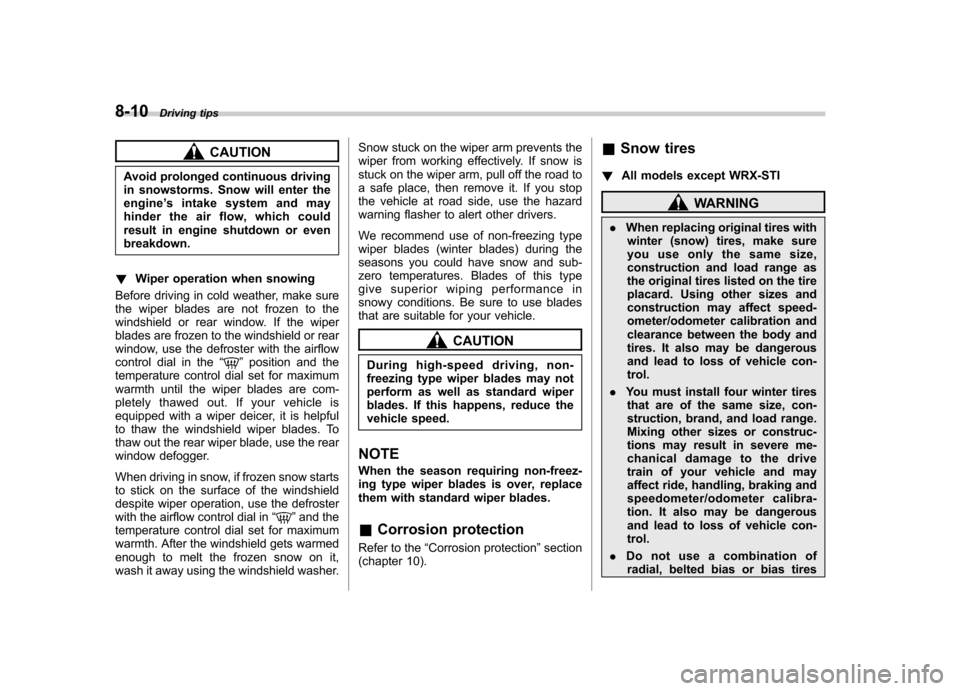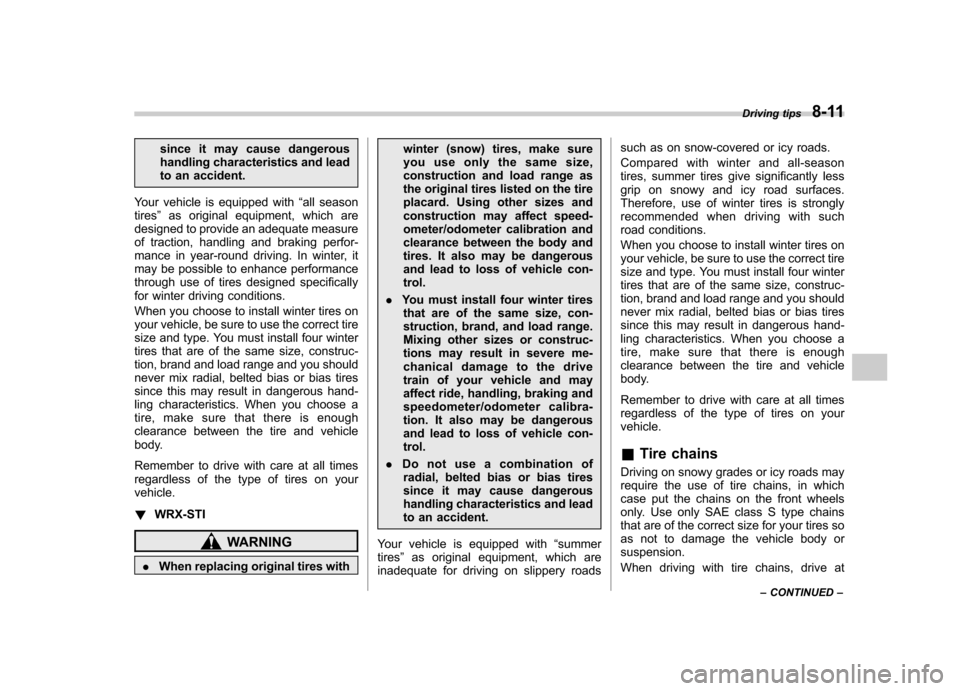2007 SUBARU IMPREZA odometer
[x] Cancel search: odometerPage 110 of 364

Ignition switch..................................................... 3-3
LOCK .................................................................. 3-3
Acc..................................................................... 3-4
ON...................................................................... 3-4
START ................................................................ 3-4
Key reminder chime ............................................ 3-5
Ignition switch light ............................................. 3-5
Key interlock release (AT vehicles only) ... ............ 3-5
Hazard warning flasher ....................................... 3-6
Meters and gauges (WRX-STI) ........................... 3-6
Combination meter illumination ........................... 3-6
Canceling sequential illumination of the combination meter ............................................ 3-6
Speedometer ....................................................... 3-7
Odometer/Trip meter ............................................ 3-7
Tachometer ......................................................... 3-7
Fuel gauge .......................................................... 3-8
Temperature gauge ............................................. 3-8
Outside temperature indicator ............................. 3-9
REV indicator light and buzzer (WRX-STI) ........ 3-9
Setting the alarm-level engine speed ................... 3-10
Deactivating the REV alarm system ..................... 3-11
Meters and gauges (Except WRX-STI) .............. 3-11
Speedometer ...................................................... 3-11
Odometer/Trip meter ........................................... 3-11
Tachometer ........................................................ 3-12
Fuel gauge ......................................................... 3-12
Temperature gauge ............................................ 3-13
Outside temperature indicator ............................ 3-13
Warning and indicator lights ............................. 3-14
Seatbelt warning light and chime ........................ 3-14SRS airbag system warning light
........................ 3-14
Front passenger ’s frontal airbag ON and OFF
indicators ........................................................ 3-15
CHECK ENGINE warning light/Malfunction indicator lamp ................................................. 3-16
Charge warning light .......................................... 3-16
Oil pressure warning light .................................. 3-16
AT OIL TEMPerature warning light (AT vehicles) .................................................... 3-17
Rear differential oil temperature warning light (WRX-STI) ........................................................ 3-17
ABS warning light .............................................. 3-17
Brake system warning light ................................ 3-18
Door open warning light .................................... 3-19
All-Wheel Drive warning light (AWD AT vehicles –
if equipped) ..................................................... 3-19
Intercooler water spray warning light (WRX-STI) ........................................................ 3-19
Selector lever position indicator (AT vehicles) .................................................... 3-20
Turn signal indicator lights ................................. 3-20
High beam indicator light ................................... 3-20
Cruise control indicator light .............................. 3-20
Cruise control set indicator light ........................ 3-20
Driver ’s control center differential auto indicator
light (WRX-STI) ................................................ 3-20
Driver ’s control center differential indicator and
warning lights (WRX-STI) ................................. 3-21
Lights indicator light (WRX-STI) ......................... 3-21
REV indicator light (WRX-STI) .. .......................... 3-21
Clock .................................................................. 3-22Instruments and controls
3
Page 116 of 364

&Speedometer
The speedometer shows the vehicle speed. & Odometer/Trip meter
1) Trip meter
2) Odometer
This meter displays the odometer and two
trip meters when the ignition switch is inthe “LOCK ”, “Acc ”or “ON ”position.
If you press the trip knob when the ignition
switch is in the “LOCK ”position, the
odometer/trip meter will light up. It is
possible to switch between the A trip
meter and B trip meter indications while
the odometer/trip meter is lit up. If you do
not press the trip knob within 10 seconds
of illumination of the odometer/trip meter, the odometer/trip meter will go off. !
Odometer
The odometer shows the total distance
that the vehicle has been driven. ! Double trip meter
The trip meter shows the distance that the
vehicle has been driven since you last set
it to zero.
To change the mode indication, briefly
push the knob.
Each press of the knob changes the
function alternately.
To set the trip meter to zero, select the A
trip or B trip meter by pushing the knob
and keep the knob pushed for more than 2 seconds.
CAUTION
To ensure safety, do not attempt to
change the function of the indicator
during driving, as an accident couldresult.
NOTE
If the connection between the combina-
tion meter and battery is broken for any
reason such as vehicle maintenance or
fuse replacement, the data recorded on
the trip meter will be lost. & Tachometer
The tachometer shows the engine speed
in thousands of revolutions per minute.
CAUTION
Do not operate the engine with the
pointer of the tachometer in the red
zone. In this range, fuel injection will
be cut by the engine control module
to protect the engine from overrev-
ving. The engine will resume run-
ning normally after the engine speed
is reduced below the red zone. Instruments and controls
3-7
– CONTINUED –
Page 120 of 364

from the engine speed shown by the
tachometer. Use the engine speed
shown by the tachometer as a roughguide. &Deactivating the REV alarm system
To deactivate the REV alarm system ’s
REV indicator light and buzzer functions,
set the alarm-level engine speed to 0
(zero) rpm. Meters and gauges (Except WRX-STI) NOTE
Liquid-crystal displays are used in
some of the meters and gauges in the
combination meter. You will find their
indications hard to see if you wear
polarized glasses. &
Speedometer
The speedometer shows the vehicle speed. & Odometer/Trip meter
1) Trip meter
2) Odometer This meter displays the odometer and two
trip meters. !
Odometer
The odometer shows the total distance
that the vehicle has been driven. ! Double trip meter
The trip meter shows the distance that the
vehicle has been driven since you last set
it to zero.
To change the mode indication, briefly
push the knob.
Each press of the knob changes the
function alternately.
Instruments and controls 3-11
– CONTINUED –
Page 236 of 364

8-10Driving tips
CAUTION
Avoid prolonged continuous driving
in snowstorms. Snow will enter the
engine ’s intake system and may
hinder the air flow, which could
result in engine shutdown or evenbreakdown.
! Wiper operation when snowing
Before driving in cold weather, make sure
the wiper blades are not frozen to the
windshield or rear window. If the wiper
blades are frozen to the windshield or rear
window, use the defroster with the airflow
control dial in the “
”position and the
temperature control dial set for maximum
warmth until the wiper blades are com-
pletely thawed out. If your vehicle is
equipped with a wiper deicer, it is helpful
to thaw the windshield wiper blades. To
thaw out the rear wiper blade, use the rear
window defogger.
When driving in snow, if frozen snow starts
to stick on the surface of the windshield
despite wiper operation, use the defroster
with the airflow control dial in “
”and the
temperature control dial set for maximum
warmth. After the windshield gets warmed
enough to melt the frozen snow on it,
wash it away using the windshield washer. Snow stuck on the wiper arm prevents the
wiper from working effectively. If snow is
stuck on the wiper arm, pull off the road to
a safe place, then remove it. If you stop
the vehicle at road side, use the hazard
warning flasher to alert other drivers.
We recommend use of non-freezing type
wiper blades (winter blades) during the
seasons you could have snow and sub-
zero temperatures. Blades of this type
give superior wiping performance in
snowy conditions. Be sure to use blades
that are suitable for your vehicle.
CAUTION
During high-speed driving, non-
freezing type wiper blades may not
perform as well as standard wiper
blades. If this happens, reduce the
vehicle speed.
NOTE
When the season requiring non-freez-
ing type wiper blades is over, replace
them with standard wiper blades. & Corrosion protection
Refer to the “Corrosion protection ”section
(chapter 10). &
Snow tires
! All models except WRX-STI
WARNING
. When replacing original tires with
winter (snow) tires, make sure
you use only the same size,
construction and load range as
the original tires listed on the tire
placard. Using other sizes and
construction may affect speed-
ometer/odometer calibration and
clearance between the body and
tires. It also may be dangerous
and lead to loss of vehicle con-trol.
. You must install four winter tires
that are of the same size, con-
struction, brand, and load range.
Mixing other sizes or construc-
tions may result in severe me-
chanical damage to the drive
train of your vehicle and may
affect ride, handling, braking and
speedometer/odometer calibra-
tion. It also may be dangerous
and lead to loss of vehicle con-trol.
. Do not use a combination of
radial, belted bias or bias tires
Page 237 of 364

since it may cause dangerous
handling characteristics and lead
to an accident.
Your vehicle is equipped with “all season
tires ”as original equipment, which are
designed to provide an adequate measure
of traction, handling and braking perfor-
mance in year-round driving. In winter, it
may be possible to enhance performance
through use of tires designed specifically
for winter driving conditions.
When you choose to install winter tires on
your vehicle, be sure to use the correct tire
size and type. You must install four winter
tires that are of the same size, construc-
tion, brand and load range and you should
never mix radial, belted bias or bias tires
since this may result in dangerous hand-
ling characteristics. When you choose a
tire, make sure that there is enough
clearance between the tire and vehicle
body.
Remember to drive with care at all times
regardless of the type of tires on yourvehicle. ! WRX-STI
WARNING
. When replacing original tires with winter (snow) tires, make sure
you use only the same size,
construction and load range as
the original tires listed on the tire
placard. Using other sizes and
construction may affect speed-
ometer/odometer calibration and
clearance between the body and
tires. It also may be dangerous
and lead to loss of vehicle con-trol.
. You must install four winter tires
that are of the same size, con-
struction, brand, and load range.
Mixing other sizes or construc-
tions may result in severe me-
chanical damage to the drive
train of your vehicle and may
affect ride, handling, braking and
speedometer/odometer calibra-
tion. It also may be dangerous
and lead to loss of vehicle con-trol.
. Do not use a combination of
radial, belted bias or bias tires
since it may cause dangerous
handling characteristics and lead
to an accident.
Your vehicle is equipped with “summer
tires ”as original equipment, which are
inadequate for driving on slippery roads such as on snow-covered or icy roads.
Compared with winter and all-season
tires, summer tires give significantly less
grip on snowy and icy road surfaces.
Therefore, use of winter tires is strongly
recommended when driving with such
road conditions.
When you choose to install winter tires on
your vehicle, be sure to use the correct tire
size and type. You must install four winter
tires that are of the same size, construc-
tion, brand and load range and you should
never mix radial, belted bias or bias tires
since this may result in dangerous hand-
ling characteristics. When you choose a
tire, make sure that there is enough
clearance between the tire and vehicle
body.
Remember to drive with care at all times
regardless of the type of tires on yourvehicle. &
Tire chains
Driving on snowy grades or icy roads may
require the use of tire chains, in which
case put the chains on the front wheels
only. Use only SAE class S type chains
that are of the correct size for your tires so
as not to damage the vehicle body orsuspension.
When driving with tire chains, drive at Driving tips
8-11
– CONTINUED –
Page 310 of 364

11-34Maintenance and service
When you install a tire that has the tire
rotation direction mark, install the tire with
the direction mark facing forward. & Tire rotation
Vehicles equipped with unidirectional tires
1) Front
Vehicles equipped with 4 non-unidirec-
tional tires
1) Front
Tire wear varies from wheel to wheel. To
maximize the life of each tire and ensure
that the tires wear uniformly, it is best to
rotate the tires every 7,500 miles (12,500
km). Move the tires to the positions shown
in the illustration each time they arerotated.
Replace any damaged or unevenly worn
tires at the time of rotation. After tire
rotation, adjust the tires pressures and
make sure the wheel nuts are correctlytightened.
After driving approximately 600 miles
(1,000 km), check the wheel nuts again
and retighten any nut that has become loose. &
Tire replacement
The wheels and tires are important and
integral parts of your vehicle ’s design;
they cannot be changed arbitrarily. The
tires fitted as standard equipment are
optimally matched to the characteristics
of the vehicle and were selected to give
the best possible combination of running
performance, ride comfort, and service
life. It is essential for every tire to have a
size and construction matching those
shown on the tire placard and to have a
speed symbol and load index matching
those shown on the tire placard.
Using tires of a non-specified size detracts
from controllability, ride comfort, braking
performance, speedometer accuracy and
odometer accuracy. It also creates incor-
rect body-to-tire clearances and inappro-
priately changes the vehicle ’s ground
clearance.
All four tires must be the same in terms of
manufacturer, brand (tread pattern), con-
struction, and size. You are advised to
replace the tires with new ones that are
identical to those fitted as standard equip-ment.
For safe vehicle operation, SUBARU
Page 359 of 364

14-6Index
M
Main fuse ................................................................. 11-44
Maintenance
Precautions ........................................................... 11-3
Schedule .............................................................. 11-3
Seatbelt ................................................................ 1-18
Tools .................................................................... 9-16
Manual Climate control system ............................................. 4-3
Transmission oil .................................................... 11-19
Transmission-5 speeds ........................................... 7-11
Transmission-6 speeds ............................................. 7-9
Map light ..................................................................... 6-2
Maximum load limits ................................................... 8-20
Meters and gauges .............................................. 3-6, 3-11
Mirrors ...................................................................... 3-32
Moonroof .................................................................. 2-24
N
New vehicle break-in driving .......................................... 8-2
O
Odometer/Tripmeter ............................................. 3-7, 3-11
Off road driving ............................................................ 8-6
Oil filter ..................................................................... 11-9
Oil level
Engine .................................................................. 11-8
Front differential gear (AT vehicles) ......................... 11-21
Manual transmission .............................................. 11-19
Rear differential .................................................... 11-22
Oil pressure warning light ............................................ 3-16 Outside mirrors
.......................................................... 3-33
Outside temperature indicator ............................... 3-9, 3-13
Overheating engine .................................................... 9-11
P Parking Brake .................................................................... 7-24
Brake stroke ........................................................ 11-30
Light switch ........................................................... 3-25
Tips ...................................................................... 7-25
Parking your vehicle ................................................... 7-24
Periodic inspections ..................................................... 8-4
Power
Door locking switch .................................................. 2-6
Steering ................................................................ 7-20
Steering fluid ........................................................ 11-24
Windows ............................................................... 2-18
Precautions against vehicle modification ................ 1-22, 1-57
Preparing to drive ........................................................ 7-6
Printed antenna ........................................................... 5-2
R Rear Combination lights ................................................ 11-49
Gate ............................................................. 2-23, 9-14
Seats ..................................................................... 1-6
Viscous limited slip differential .................................. 7-20
Rear differential Gear oil ............................................................... 11-22
Oil temperature warning light ................................... 3-17